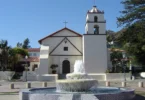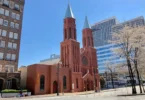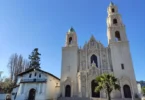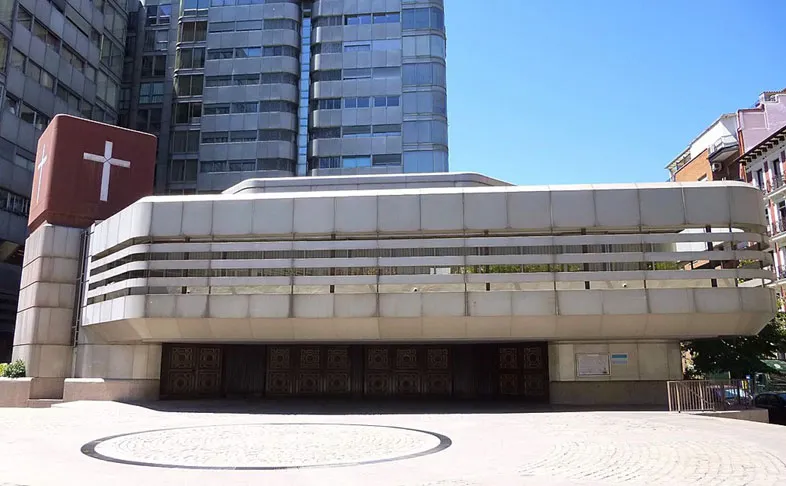
Introduction
The third church of Buen Suceso is a Catholic temple in the Spanish city of Madrid, located on Calle de la Princesa also known as Buen-Suceso Church (Nuestra Señora del Buen Suceso). The first church of Buen Suceso had been in Puerta del Sol. A second church was destroyed during the civil war, was partially restored but was finally demolished in 1975.
The building that housed the second church was declared in ruin and demolished in 1975, and a modern architectural complex was built on its site, consisting of the new Church of Buen Suceso and a residential complex. Carried out by the architect Manuel del Río along with Ignacio Ferrero Ruiz de la Prada and Juan Hernández Ferrero, it was inaugurated in 1982. Due to its appearance and the fact that its façade is covered with stainless steel, it is known as “Nuestra Señora de Magefesa.
In January 1975, the demolition of the second Buen Suceso church on Calle de la Princesa began. The following year the huge and valuable site went up for public auction and, despite protests, in 1977 the Urban Planning Department granted the construction licenses.
Calle de la Princesa was being transformed, populating shopping centers, large hotels and modern high-rise buildings, little remained of the mansions and gardens that occupied the street and its surroundings at the beginning of the 20th century.
Buen Suceso Church, Madrid – The current building was built on the site, a group of houses and offices that includes the small church. Of the many flats and premises built, a part remained in the hands of the Patronato del Buen Suceso, belonging to Patrimonio.
History of Buen Suceso Church, Madrid
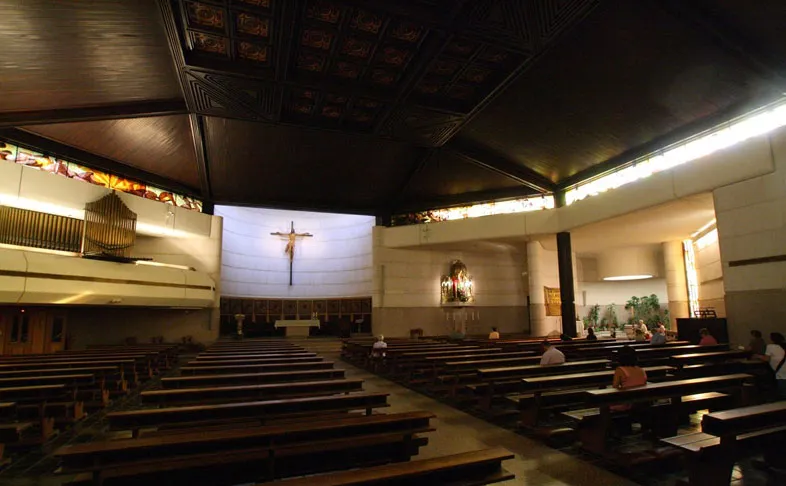
Buen Suceso Church, Madrid – The current church of Nuestra Señora del Buen Suceso, built in 1982 by the National Heritage architect Manuel del Río, is not valued and is even reviled from the historical-architectural point of view, for a time it was ironically and disparagingly known as “Our Lady of Magefesa”.
As a curiosity, although it is relevant, we can remember that in the same decade this architect also participated in the construction of the famous Windsor building, in AZCA, which disappeared a few years ago in a fire. This building was part of an architectural renovation that took place at that time, especially innovative in terms of the materials used.
The exterior of the Buen Suceso Church, Madrid is very simple, only topped with a dark cube on top with a cross. Its interior, although it is also very simple, hides more treasures. The octagonal floor plan, ten meters on each side, is illuminated with modern stained glass windows. The wooden coffered ceiling stands out, with decoration in the center of each case.
To the left a gallery houses the organ, the third organ of Buen Suceso . The previous church, by Ortiz de Villajos, inherited the Puerta del Sol, which was not replaced by another until the reign of Alfonso XII, being installed in 1879. But this new one was destroyed in the civil war, so that in the In the 1940s a new one was created, in turn inherited by the new and modern parish.
To the right is the Chapel of the Sacrament, in the shape of a trapezoid, next to another circular space illuminated by a light from above over the stone baptismal font.
The ambo or lectern for reading or singing in liturgical functions, built at the end of the 19th century, is also preserved from the previous era . It is made of alabaster, with a golden shaft from the old altar, and a polished pink marble base.
The image of Our Lady of Good Success, venerated by the residents of the Argüelles neighborhood on Calle de la Princesa, is the same one that was found by the Obregones brothers in a cave at the beginning of the 17th century, and that was in the Puerta del Sol until the first church was demolished in the 19th century.
It is an image of clothing, carved in cypress wood. It measures 53 centimeters, the arms are articulated, and the hands painted flesh-colored, on the left it holds the Child, who measures about eleven centimeters, and on the right a scepter. The dressing room in which it has been located since the 1960s is the bronze altarpiece built at the end of the 19th century for the main altar of the previous temple.
Apart from religious questions, there are many reasons to encourage us to visit this church in the heart of the Arguelles neighborhood. This summer, on a Saturday morning, around ten o’clock, a time when the warm light filters through the windows, we have been able to verify that behind that cold facade to which the neighbors have already become accustomed, valuable things are hidden and, above all, everything hides several centuries of history.
Iglesia del Buen Suceso
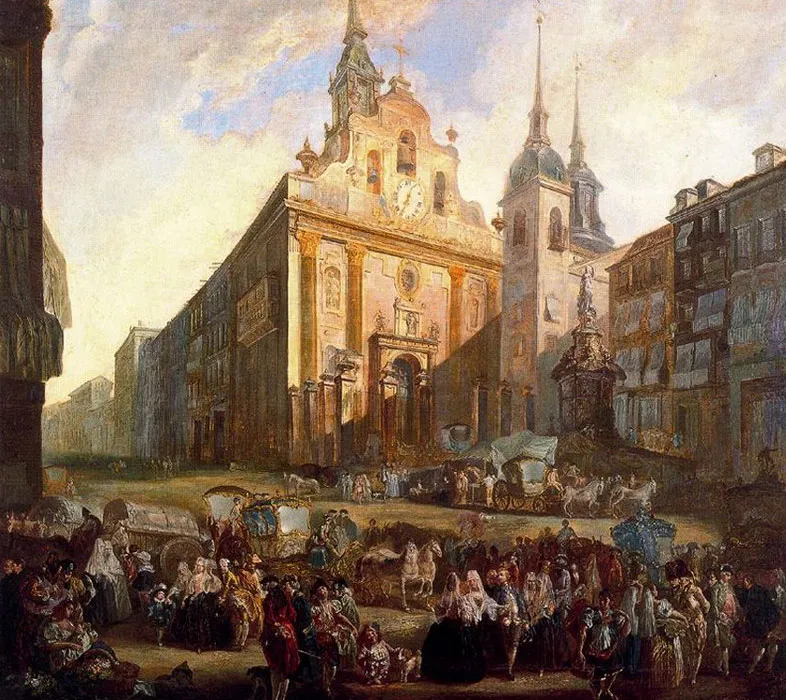
The Iglesia de Nuestra Señora del Buen Suceso, commonly known as Iglesia del Buen Suceso was a church of Madrid that delimited the eastern part of the Puerta del Sol (Madrid). The church comes from a remodeling of the Hospital Real de la Corte (Royal Hospital of the Court) (built in 1483). Was doing functions of church and hospital since 1590. Its lonja was meeting place for several centuries.
The church’s clock would be important during this period until it was installed one of better performance on the Real Casa de Correos. Its demolition coincided with the Confiscation of Mendizábal that left space for the later expansion that was done for the Puerta del Sol.
Archaeological remains of various parts of the church were found beneath it in 2006, during an extension of the Madrid Metro connecting Sol Metro Station with Cercanías Madrid, causing a 6-month delay in construction. The remains were later restored and displayed in Sol Station.
This building was founded by Pious Bernardino de Obregón, founder of the Hospital of the Buen Suceso in the Villa of Madrid, and married with Catalina de Pareja, (daughter of Antón de Pareja, alcaide of Zambrana y Rute and of María Díez), and granddaughter of Gonzalo de Pareja, married in Baena with Isabel Ramírez (daughter of Francisco Ramírez, Captain General of Granada).
The history of this building has been investigated by many scholars: Antonio Palomino, Ponz, Madoz, Mesonero Romanos, and Ramón Gómez de la Serna. The area had been the location of neon sign advertising “Tío Pepe” between Calle de Alcalá and Carrera de San Jerónimo, and was once occupied by a hospital. There were successive constructions and renovations of the building. Some authors suggest that the Philip II did the design during its stay in Valladolid between 1601 and 1607. Although the idea that Francisco de Mora could be a primary ideador of the first building.
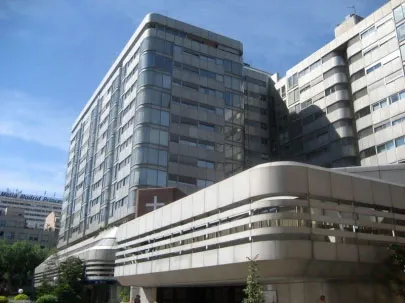
Moving of Hospital to Madrid
Its origin is in a traveling hospital that accompanied the Spanish Court, the Hospital Real de la Corte, which was founded by the Catholic Monarchs in Baza in 1489. The mission of that Hospital was to attend diseases and accidents that had the Courtiers surrounding the King. The emperor Charles V, Holy Roman Emperor it moved definitively to the fledgling city of Madrid, sending build outside the City Walls, next to the Puerta del Sol.
Its foundation is confirmed on 1529. in a bull of Pope Clement VII on 28 January 1529, in which after name him Administrator, was recognized to him powers to reform and again issue any pius statutes and licits and honests ordinances not contrary to the Sacred Canons.
The hospital is built in the area that was in the eastern part of Puerta del Sol, a space that had been occupied by the old Hermitage and shrine of San Andrés. Other authors mention the existence of a parish of Corpus Christi. The construction is made with little homogeneity and this feature makes that from the beginning be a building much needed of constant reforms. Its conditioning as sanitary facilities was made slowly and in 1561 the hospital was complete.
From an architectural point of view the conditioning of the modest hospital did not have any other particular compared with the eighteen health facilities existing in that time in Madrid. However, being a work under the royal patronage, it was not of the worst equipped. The poor materials used in the construction soon start to sag and this is an excuse for its renovation.
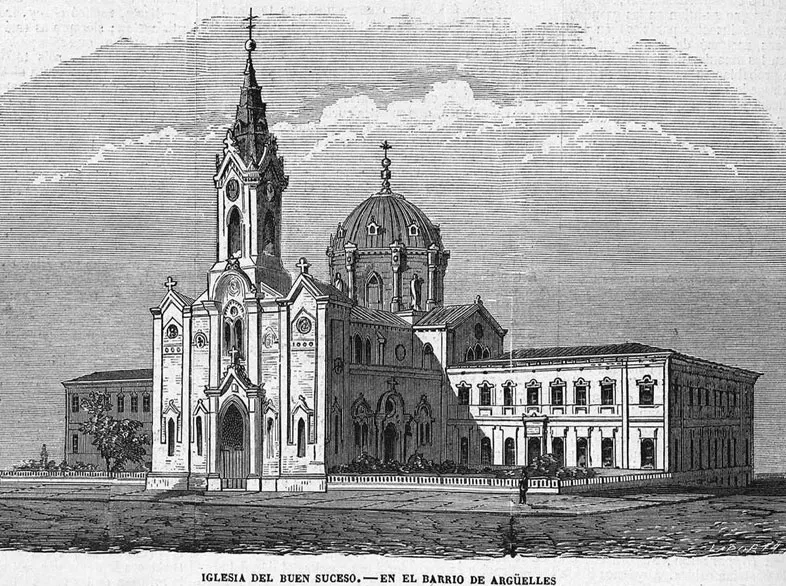
Construction of the Church
In 1587 Philip II orders a hospitalary reduction in the villa of Madrid. In 1567 demolished some walls of Carrera de San Jerónimo and were confiscated neighbor houses and that do nothing than consolidate the zone area. The small Church of the Hospital is slowly taking representative functions of city center.
On 1590 the foundation of the hospital building show signs of weakness. Philip II entrusts to the Police Board of Madrid to build a new church and nursing in the place of the Royal Hospital, appointing for that to architect Diego Sillero and other officers. Diego Sillero, along with his father, had dedicated to other buildings in the city, although that designs would come from the study of Juan de Herrera. Proceed to demolition of the old building.
The death of Juan de Herrera, inspirer of the work, cause a delay in the renovation. The reason for the delay were mainly economic, there was a shortage of funds did not allow the cost of a new building. The work remained stopped some years. On 1601 Philip III “the Devotional” decided to move the Court to Valladolid. Architect Francisco de Mora is the newly elected chief architect of the King. On 1606 the Court returns to Madrid, this event reactivate the construction of the church.
The stonework is carried out by Agustín de Argüelles. It is not known if it was the need to attend to the cult, or the new care demands, but the construction was accelerated. The church was completed on September 1611. The altar was placed on 1612 and side chapels were finished on 1628. The first description of the church in the Puerta del Sol is that made Fernández Herrera to describe the Bernadino de Obregón’s life:
… it has built a grandiose building, put in the best of Madrid at the gate called del Sol, at beginning of that they call carrera de San Jerónimo and at the end of the famous Calle Mayor (…) the church bordering the square, as well locked in the curtain that serve of lonja its entrance to the building, with a colorful and capable guardrail, gracefully dilating between the two streets of Alcalá and San Jeronimo, with a colorful and opulent façade, turning its backs the hospital building by both hazes, with great eminence in trace and form …
— Fernández Herrera
After these other descriptions of several authors as Pedro de la Torre, Ruiz de Altable, among others. The space of the Puerta del Sol of Madrid is divided in 17th century into two: the eastern starring the lonja of the Buen Suceso (that meet the Calle de Alcalá and carrera de San Jerónimo), and the western part occupied by the Monasterio de San Felipe and the lonja (the called “mentidero”).
The wide passage that joined corresponded to the space of the Puerta del Sol. On 1695 is detected that one of the canvases of the church threatens ruin. It chooses to expand at the expense of the lonja, although this entails raise a new façade and modify the dome. In the new façade survives, under a semicircular arch between lintels, the former Doric portal with royal shields. The building had to be adapted to the trapezoidal shape of the plot. The new church was terminated on 1700.
Our Lady of Good Success
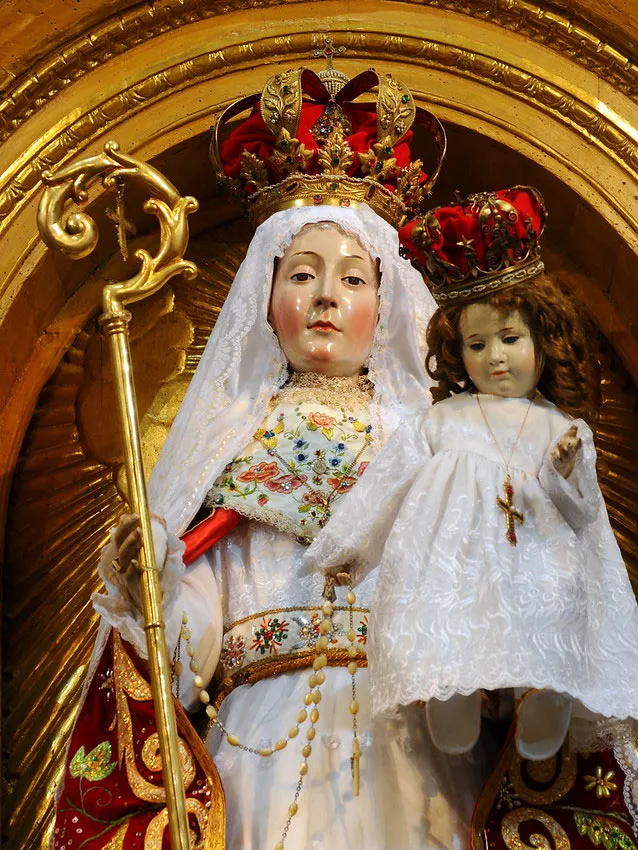
Our Lady of Good Success (Spanish: Nuestra Señora del Buen Suceso; Filipino: Ina ng Mabubuting Pangyayari), also called Our Lady of the Good Success, is one of the titles of Blessed Virgin Mary. This title is shared among numerous images around the world — a number of images in Spain, one in Quito, Ecuador, and one in Parañaque City, Philippines. It is claimed that Quito’s image had produced an apparition – to Mother Mariana de Jésus Torres.
Two Spanish friars, Brothers Gabriel de Fontaned and Guillermo de Rigosa traveled to Rome to meet the Pope for the approval of their order (The Order of Minims for the Service of the Sick or The Order of Saint Francis of Paola). As they were passing through the town of Traigueras (under the jurisdiction of Tortosa in the Principate of Catalonia), a furious storm descended upon them. The brothers prayed for God’s guidance and help.
Immediately they saw a mysterious light coming from a cave in a cliff. Climbing up, they entered and found a beautiful statue of the Virgin Mary holding the Baby Jesus in her arms. They reported being surrounded by shimmering lights and fragrant scents. As no one claimed the statue, the two carried it with them, hoping that the Blessed Mother would help in getting approval for their order.
On arriving in Rome, the brothers were worried that they might not obtain papal consent. However, Pope Paul V on hearing the story of their journey, knelt before the statue and placed his pectoral cross around its neck. As he embraced and kissed the statue, he said:
“Look Brothers! She is smiling! Why does she smile so? What good success you have had on this journey! There is no doubt that Our Lady has deigned to protect and support you in your work. Therefore it will not be me that will go against Her. May all of your efforts obtain good success!”
He then blessed it and christened her Our Lady of Good Success. The image was placed in the Royal Hospital of Madrid, where it became famous “for the numerous favors granted by Heaven through her”. In 1641, Philip III ordered the construction of the Church of Our Lady of Good Success. This enshrines the image renowned among the churches of Madrid. Soon, as its popularity and devotion spread, the image was replicated in several places in Spain: Orduña, La Puebla de Gordon, Tudela, Abla, among others.
There is a representation of ‘Virgen de la Buena Suerte” in the chapel of the Catholic Monarchs in Granada, Spain. Another image with the same name is located in Prats de Llusanès, Barcelona.
In 1577 five Conceptionist sisters traveled from Spain to Quito, Ecuador to start the first convent. Mariana de Jésus Torres, one of the young nuns, is said to have seen the Blessed Mother. On February 2, 1610, as Mariana was praying, the Blessed Mother appeared to her and commanded a statue to be made to her likeness.
Apparition in Ecuador (1594-1634)
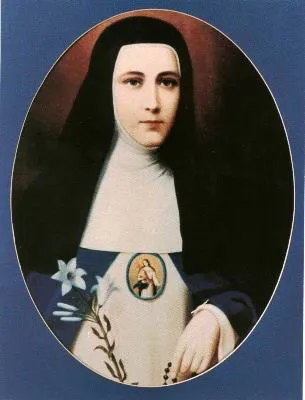
A Conceptionist sister named Mariana Francisca de Jesús Torres claimed to have received Marian apparitions under this title from 2 February 1594 to 2 February 1634 in Quito. In 1611, the local bishop, Salvador Ribera Avalos, gave his approval to the apparitions that had occurred up to that point.
During these apparitions of not only the Blessed Mother, but our Lord as well, a startling series of messages took shape which seemed remarkably unimportant to the age in which Mother Mariana lived. In fact, several concerned events that she was told would not take place for another 350 years (“shortly after the middle of the 20th century”)! But the remarkable accuracy in which these warnings describe our world today, lends creedence to their authenticity.
Mother Mariana passed away in 1635. In the year 1906, her body was disinterred and discovered to be incorrupt.
In 1986, the cause for Mother Mariana’s beatification was opened, and in 1997 the matter was placed in the hands of Rome.
“First so that men in the future might realize how powerful I am in placating Divine Justice and obtaining mercy and pardon for every sinner who comes to me with a contrite heart. For I am the Mother of Mercy and in me there is only goodness and love. When tribulations of spirit and sufferings of the body oppress them and they seem to be drowning in this bottomless sea let them gaze at my holy image and I will always be there ready to listen to their cries and soothe their pain. Tell them that they should always run to their Mother with confidence and love…”
Over the course of ten years Mother Mariana struggled with the issue of completing the statue. Many obstacles prevented its sculpting. One obstacle was a fear of idolatry on the part of the native people in Quito. Another was Mother Mariana’s personal fear of not being believed and thus putting the convent in jeopardy. In the year 1610, she asked the permission of the Bishop to create the statue. The sculpting of the statue of Our Lady of Good Success was given to Francisco del Castillo.
Castillo was chosen as he was a talented sculptor and a devotee of the Blessed Mother. The statue of Our Lady of Good Success was blessed on February 2, 1611. On that day, she was placed above the seat of the Abbess chair at her own specific request as a sign to all that she was the one who governed and watched over the convent. Her official title being that of “Mary of Good Success of the Purification”.
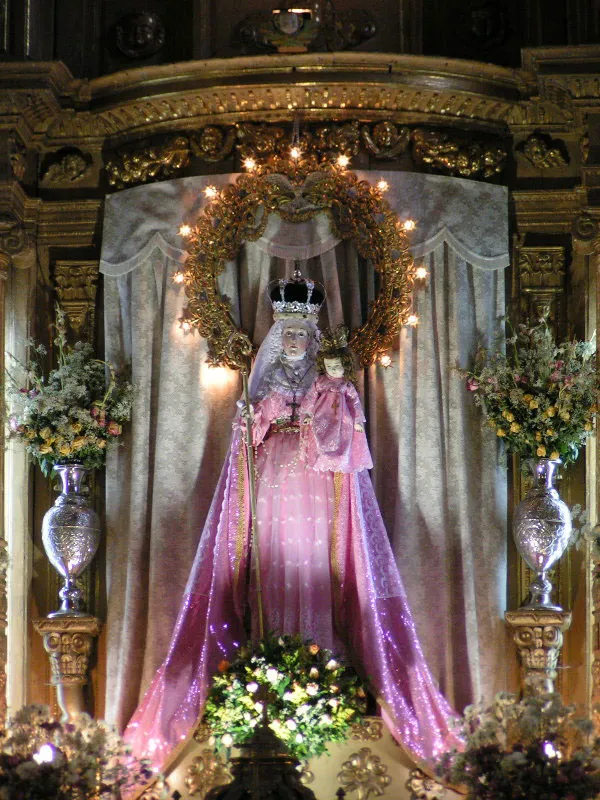
Dos de Mayo Uprising
During the Uprising of 2 May of 1808 the church suffered serious damage to its façade and interior. The struggles that occur against the French troops in the Puerta del Sol seriously affect its structure. Struggles to become the Iglesia del Buen Suceso in a symbol of the Madrilenian resistance. But the years passed after this event and it was not until 1839 would again completely reform under the direction by Narciso Pascual Colomer that aims to design the church to accommodate to the architectural preferences of the time.
Previously by Royal Order of December 12, 1832 enacted a new “Ordinances for the good order, regime and governance of the Royal Parish Church and Hospital of the Court called Nuestra Señora del Buen Suceso”, which suppress the Governing Board.
The Major Reform of the Puerta del Sol (Demolition)
Due to the reform of the Puerta del Sol, the February 24, 1854 begins the demolition of the church and the hospital. Of the building remains only a columns that were brought to the Casa de Bruguera, in the Paseo de la Castellana.
The Clock it wore the façade and that was reference time of the passersby in the Puerta del Sol went to the Real Casa de Correos and has since become in the Clock of the Governorate (Clock of the Puerta del Sol). The church disappears completely from the Puerta del Sol, in its place is constructed the Grand Hôtel de París, which after in mid-20th century receives the famous “Tio Pepe” neon sign.
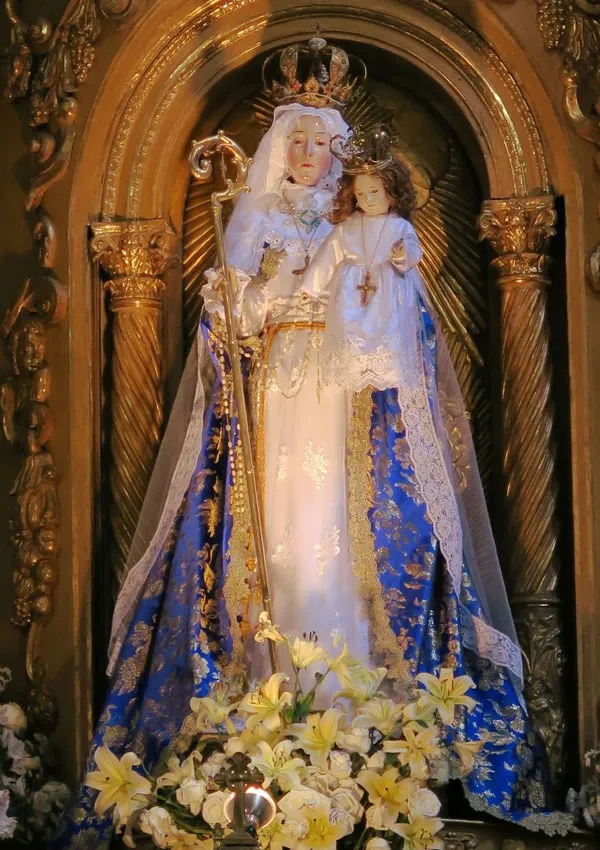
Rediscovery
The renovation work planned its inception on 2005, were found its foundations by surprise on 2006. The surprise was that these remains appear to a meter and a half deep. It was not expected to find remains in such good condition after many works carried out by the Madrid Metro in tunneling during the 1910s. Plans to move the remains to another place of Madrid were not implemented. Instead they were buried a few meters below the foundations and can be seen in the access corridors from Cercanías de Madrid to the Metro in the Estación de Sol.
New Site
Both were transferred to the then new Argüelles neighborhood (by that time Pozas) on the current site of Princesa 43. In 1868 was inaugurated the new Iglesia del Buen Suceso in calle de Princesa, work by Agustín Ortiz de Villajos. Under Amadeo I “the Gentleman king”, el Buen Suceso become to depend administratively by the General Directorate of the Royal House and Heritage, which imposed the obligation to prepare annual budgets.
The Restoration establish for the Patronage new tasks, such as the public and free consultation and cure and the aid in accidents occurred on public roads, while assuming additional functions such as the special hospital for diseases of children and sick Home of Health for sick pensioners. During the Spanish Civil War in full defense of Madrid, the church is closed and the hospital continues functioning. The area is devastated by intense artillery bombardment, and the church is completely in ruins.
After the war the building was reconstructed. The Act of March 7, 1940 the Royal Patronage is integrated to the National Heritage with the rest of the former Royals Patronages. The final decline of the hospital is marked by resolution of the Board of Administration of the National Heritage of June 9, 1942, by which it removed the hospital services of el Buen Suceso, which become covered by the Directorate General of Health of the Army of Air, using the same building through a lease.
This meant, in fact, the liquidation of the historic Patronage, by depriving of its essential purpose, even if, in law, it has prolonged its existence until today. The religious cult continues until now, thanks to the agreement signed by the National Heritage and the Diocese of Madrid-Alcalá, whereby is ceded the building for the operation of the new parish of the Blessed Corpus Christi in the Iglesia del Buen Suceso.
On January 1975 began the demolition of the building that then threatens ruin. The city block, between the streets Princesa, Quintana, Tutor and Buen Suceso was designed by architects Manuel del Río Martínez, Ignacio Ferrero Ruiz-de la Prada and Juan Hernández Ferrero. The action includes a new residential and commercial building with metal façade and a new church to match the building.
The new church was opened for worship on 17 April 1982. On October 22, 2006, to commemorate the fourth centenary of the discovery of the image, in a ceremony celebrated by Antonio María Rouco Varela (Cardinal Archbishop of Madrid, José Luis Huéscar Cañizal (episcopal vicar), the Nuestra Señora del Buen Suceso’s pastor, Miguel Jimeno, and the Ukrainian Greco-catholic Community’s chaplain, Ivan Lypko, is canonically crown the statue of Our Lady of Good Success in the parish. This current building is popularly called, ironically and contemptuously, in derogative as “Our Lady of the Magefesa” linking its shape with a toaster.
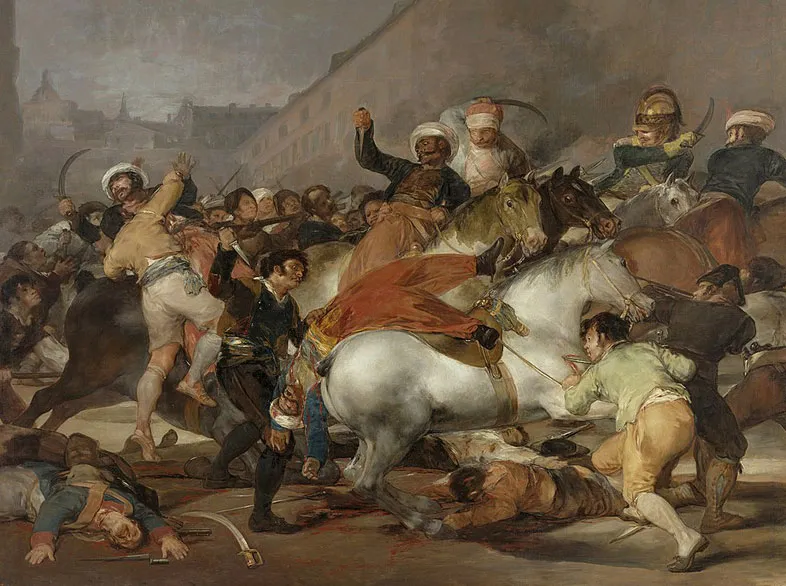
Features
There are few documents that describe the Iglesia del Buen Suceso, especially in regard to the floor layout. The partial descriptions of its conditioning and some engravings and representations of the time give ideas about its presence. There contemporary descriptions of Herrera Maldonado and Ruiz de Altable. The church’s entrance had a lonja. The floor layout was in Greek cross with a very developed chancel and four chapels in the corners of intersection of both arms.
The style of the church, by 17th century engravings, had characteristics of the classical Mannerism. Ruiz de Altable mentions that the church building: possessed eighty feet long, sixty wide and rises in corresponding height. The altarpiece, disappeared after the demolition of 1853, it was one of the first examples of the Madrilenian Baroque.
This Church in Paintings
- Feast day in the Puerta del Sol (1773) by Luis Paret, National Museum of Havana.
- Ornato of the Puerta del Sol at the entrance of Charles III, anonymous painting of the 17th century, Museo de Historia de Madrid.
- Twelfth Night at the Puerta del Sol (1839) by José Castelaro, Museo de Historia de Madrid.
- Madrilenian types in the Puerta del Sol (1855) by Ramón Cortés.
- Critical travel around the Puerta del Sol (1874) by Manuel Ossorio y Bernard.
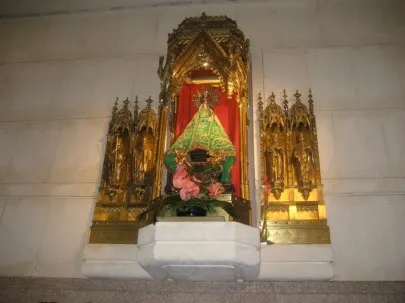
Prophetic Messages
According to the Traditionalist Catholic organization Tradition in Action, which dissents from the Catholic Church’s Second Vatican Council, a series of apparitions of under the title of Our Lady of the Good Success in the 1600’s prophesied about the 19th and 20th century. A leader of this group, Marian T. Horvat, has published a series of pamphlets and books conveying these messages, purportedly based off of temporarily lost manuscripts.
The apparition messages predict a “spiritual catastrophe” in the Catholic Church and in society, beginning “shortly after the middle of the twentieth century” and including:
- Widespread moral corruption
- Profanation of the Sacrament of Matrimony
- Depraved priests who will scandalize the faithful and cause suffering for good priests
- Unbridled lust which will ensnare many souls
- Loss of innocence among children and loss of modesty among women
- Lack of priestly and religious vocations
The messages prophesy that the period of catastrophe will be followed by a period of restoration.
On 8 December 1634, the apparition predicted that papal infallibility “will be declared a dogma of the Faith by the same Pope chosen to proclaim the dogma of the Mystery of My Immaculate Conception.” In 1854, Pope Pius IX defined the dogma of the Immaculate Conception, and in 1870, he declared the dogma of papal infallibility as defined by the First Vatican Council.
Feast Day - 2nd February
In Ecuador and Spain, the feast day of Our Lady of Good Success is celebrated on February 2nd the day she appeared to Mother Mariana along with the archangels and St. Francis of Assisi (thus coinciding with the Feast of the Purification).
Mass Time
Weekdays
- 9:00 am
- 12:00 (Noon)
- 1:30 pm
- 7:00 pm
- 8:30 pm
Sundays
- 7:30 am
- 9:00 am
- 10:30 am
- 12:00 (Noon)
- 1:30 pm
- 3:00 pm
- 7:00 pm
- 8:30 pm
Church Visiting Time
Winter
- Weekdays : 8:45 am to 2:10 pm & 6:15 pm to 9:15 pm
- Sundays : 8:45 am to 2:30 pm & 6:15 pm to 9:30 pm
Summer
- Weekdays : 8:45 am to 12:50 pm & 6:30 pm to 9:15 pm
- Sundays : 8:45 am to 2:15 pm & 6:30 pm to 9:15 pm
Contact Info
Calle Princesa, 43, 28008,
Madrid, Spain
Phone No.
Tel : +34 915 48 22 45
Accommodations
How to reach the Church
Adolfo Suárez Madrid–Barajas Airport also known as Madrid–Barajas Airport at Madrid, Spain is the nearby airport to the Church.
Sol Subway Station & Gran Vía Subway Station in Madrid, Spain is the nearby Train Stations to the Church.




